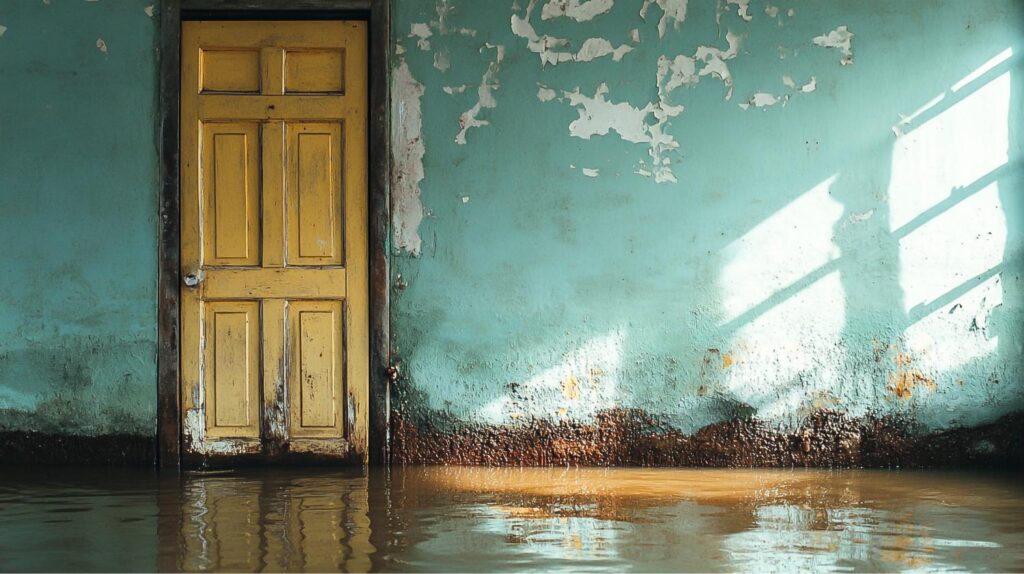
Contents
Post-flood environments are breeding grounds for mold, which can develop within 24 to 48 hours. You might think a simple cleanup is enough, but hidden growth often remains undetected. Employing expert techniques for mold removal isn’t just about visibility; it’s about thorough assessment and targeted action. Understanding the processes and equipment used by professionals can make a significant difference in the safety and health of your home. What steps should you consider for effective remediation?
Key Takeaways
- Expert techniques ensure thorough assessment and identification of harmful mold species, safeguarding health during the remediation process.
- Professionals utilize advanced equipment like moisture meters and thermal cameras to detect hidden mold and moisture sources effectively.
- Tailored remediation plans address visible mold and implement preventive strategies, reducing the risk of future outbreaks.
- Proper removal techniques employed by experts ensure complete eradication of mold, promoting a safe living environment.
- Utilizing expert services provides peace of mind with ensures and follow-up support for long-term mold-free assurance.
Understanding the Risks of Post-Flood Mold Growth
When a flood occurs, the immediate concern often revolves around structural damage and water removal, but it’s vital to recognize that mold growth can begin within 24 to 48 hours if moisture isn’t adequately addressed.
This rapid onset poses serious health risks, as mold spores can lead to respiratory issues, allergic reactions, and other health complications. You should be aware that certain environments, like damp basements or poorly ventilated areas, heighten mold growth potential.
Maintaining humidity levels below 60% is key in preventing mold proliferation. Utilize dehumidifiers and ensure proper air circulation to mitigate moisture retention.
Inspect hidden spaces, such as behind walls and under carpets, where mold can thrive unnoticed. By understanding these risks, you empower yourself to take proactive measures, safeguarding your home’s integrity and the well-being of those living within it.
Mold prevention is a collective responsibility that fosters a safe and healthy community.
The Importance of Professional Assessment
Although you may feel confident in handling minor mold issues on your own, a professional assessment is essential for effectively addressing post-flood mold growth.
Experts possess the specialized training to identify mold species that could pose health risks, as well as assess the extent of contamination. They use advanced tools like moisture meters and thermal imaging cameras to pinpoint hidden mold growth behind walls or under flooring—areas you might overlook.
Moreover, professionals can evaluate the structural integrity of your property, ensuring that any water-damaged materials are appropriately managed.
They’ll develop a tailored remediation plan that addresses visible mold and prevents future outbreaks. By trusting a professional, you’re ensuring that the assessment process is thorough and compliant with safety standards.
This approach protects your health and fosters a sense of community as you’re engaging with experts committed to restoring safe living environments.
Advanced Water Extraction Techniques
To effectively manage water damage, you’ll need to employ specialized equipment designed for rapid water extraction.
Utilizing high-capacity pumps and industrial-grade dehumidifiers accelerates the drying process, minimizing the risk of mold growth.
Specialized Equipment Utilization
While effective mold removal hinges on thorough moisture elimination, utilizing specialized equipment for advanced water extraction is essential in post-flood scenarios. This equipment considerably enhances your ability to remove water quickly and efficiently.
| Equipment Type | Purpose |
|---|---|
| High-powered Extractors | Remove standing water rapidly |
| Dehumidifiers | Lower humidity levels effectively |
| Infrared Cameras | Detect hidden moisture sources |
| Air Movers | Enhance airflow for drying |
| Submersible Pumps | Extract deep water from spaces |
Rapid Drying Methods
When tackling post-flood recovery, employing rapid drying methods is crucial for preventing mold growth and structural damage.
You should utilize advanced water extraction techniques, like high-capacity pumps and industrial-grade dehumidifiers, to remove moisture efficiently. Start by extracting standing water using submersible pumps, then follow up with air movers to circulate air and speed up evaporation.
Position these strategically to ensure ideal airflow across wet surfaces. Monitor humidity levels with hygrometers, aiming for below 60% to inhibit mold proliferation.
Additionally, consider thermal imaging to identify hidden moisture pockets. By implementing these methods, you protect your property and foster a safe environment for your family or tenants, reinforcing your commitment to a healthy living space.
Specialized Equipment for Mold Remediation
Effective mold remediation relies heavily on specialized equipment designed to tackle various stages of the removal process.
This equipment ensures that you can efficiently and effectively eliminate mold while minimizing health risks. By utilizing the right tools, you can achieve a thorough remediation that protects your space and its occupants.
Here’s a list of essential equipment for mold remediation:
- HEPA Vacuums: These vacuums filter out mold spores, capturing them effectively during cleanup.
- Moisture Meters: Use these to detect hidden moisture levels, which are fundamental for preventing mold regrowth.
- Air Scrubbers: These machines filter and purify the air, removing airborne mold spores and pollutants.
- Dehumidifiers: Crucial for lowering humidity levels, they help create an environment that’s less conducive to mold growth.
Investing in specialized equipment is essential for effective mold remediation, ensuring you restore your space safely and thoroughly.
Effective Mold Removal Strategies
To effectively tackle mold removal, you must first assess the extent of the mold damage in your environment.
Employing professional removal techniques ensures thorough eradication while minimizing health risks.
Additionally, implementing preventative measures will help safeguard your space against future mold growth.
Assessing Mold Damage
Mold damage assessment is essential after a flood, as it directly impacts the safety and livability of your space.
To effectively evaluate the extent of mold damage, follow these key steps:
Inspect all affected areas: Check walls, ceilings, and floors for visible mold growth or discoloration.
Assess moisture levels: Use a moisture meter to detect hidden dampness that can promote mold growth.
Evaluate ventilation: Confirm that airflow is adequate, as poor ventilation can exacerbate mold problems.
Document findings: Take photos and notes to create a clear record of the damage, which will aid in planning for removal.
Professional Removal Techniques
After evaluating the mold damage, addressing the issue promptly becomes essential to restore a safe environment. Professional removal techniques ensure the thorough eradication of mold spores and the prevention of future growth. Experts typically use methods like HEPA vacuuming, antimicrobial treatments, and controlled demolition to tackle the problem effectively.
| Technique | Description |
|---|---|
| HEPA Vacuuming | Removes mold spores from surfaces and air. |
| Antimicrobial Treatments | Disinfects affected areas to kill mold. |
| Controlled Demolition | Safely removes severely contaminated materials. |
| Dehumidification | Reduces moisture levels to prevent regrowth. |
| Air Scrubbing | Cleans the air of mold spores and allergens. |
Investing in these expert techniques ensures a thorough solution, ensuring your space is safe and healthy for everyone.
Preventative Measures Implemented
While you may have successfully removed the mold, implementing preventative measures is essential to ensure it doesn’t return.
By taking proactive steps, you can create an environment where mold struggles to thrive. Here are some effective strategies to evaluate:
Control Humidity: Keep indoor humidity below 60% with dehumidifiers and proper ventilation.
Seal Leaks: Regularly inspect and repair any plumbing leaks or roof issues to prevent water intrusion.
Insulate Properly: Insulate walls, attics, and crawl spaces to reduce condensation and moisture buildup.
Perform Regular Inspections: Regularly check vulnerable areas, such as basements and bathrooms, for signs of moisture or mold growth.
Safety Protocols for Mold Cleanup
When tackling mold cleanup, it’s crucial to prioritize safety to protect yourself and others from exposure. Start by wearing appropriate personal protective equipment (PPE), including N95 respirators, gloves, and goggles, to minimize inhalation and skin contact with mold spores.
Verify the workspace is well-ventilated; open windows and use exhaust fans to circulate air effectively. Before you begin, seal off the affected area with plastic sheeting to prevent spores from spreading to other parts of your home.
Use a damp cloth to wipe surfaces, as this helps contain mold particles. If the mold covers an extensive area (greater than 10 square feet), consider hiring professionals trained in mold remediation.
After cleanup, properly dispose of contaminated materials in sealed bags. Always wash your hands thoroughly after handling any mold-affected items.
Preventing Future Mold Growth
To effectively prevent future mold growth, you must control moisture levels in your home since excessive humidity creates an ideal environment for mold spores to thrive.
You can take several proactive measures to maintain a dry, mold-free environment:
Use a Dehumidifier: Keep indoor humidity levels below 60% by employing a dehumidifier, especially in damp areas like basements.
Seal Leaks: Inspect your home for leaks in roofs, walls, and plumbing. Seal any identified leaks to prevent water intrusion.
Ventilate Properly: Ascertain that your home is well-ventilated. Use exhaust fans in bathrooms and kitchens to reduce humidity.
Regular Inspections: Conduct routine checks for signs of mold or water damage, addressing any issues immediately to prevent escalation.
The Long-Term Benefits of Expert Services
Maintaining a mold-free environment relies on preventive measures and the expertise of professionals trained in mold remediation. By investing in expert services, you’ll experience long-term benefits that extend beyond immediate mold removal.
| Benefit | Description | Impact on Your Space |
|---|---|---|
| Thorough Assessment | Experts conduct detailed evaluations of affected areas. | Identifies hidden mold sources. |
| Advanced Techniques | Utilize specialized methods and equipment. | Ensures effective and safe removal. |
| Preventive Solutions | Offer tailored strategies to prevent future growth. | Reduces risk of recurring issues. |
| Health Safeguards | Protect against health risks associated with mold. | Promotes a safe living environment. |
| Peace of Mind | Ensures a mold-free space with follow-up support. | Builds trust in your home’s safety. |
Choosing expert services resolves current issues and fosters a secure, healthy environment for you and your loved ones.
Final Thoughts
As you contemplate the aftermath of flooding, consider the lurking threat of mold. It’s not just about removing visible spores; it’s about uncovering hidden dangers that could jeopardize your health. By opting for expert techniques in mold removal, you’re investing in a safe, sustainable environment. But what happens if you ignore the signs? The answer may surprise you. Take the proactive step now to guarantee your home remains mold-free, protecting your family and peace of mind for years.
Recent Posts
Your Trusted Guide to Flood Damage Repair
It’s essential to act quickly and methodically to mitigate any further issues from flood damage.
Comprehensive Flood Damage Repair Process Explained
Flood damage repair can seem like an insurmountable task, but it’s important to tackle it
What Is the Step-by-Step Flood Damage Repair Process?
When you face flood damage, evaluating the damage, extracting water, and drying the area are
